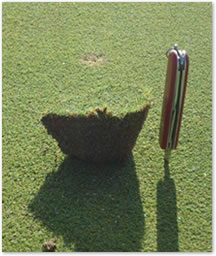 What is the importance of soil testing? It provides information necessary for selection of the correct fertilizers and soil amendments. It eliminates all of the guesswork and allows the Superintendent in getting the most efficient use of the products being applied, which will also save money. Why apply a nutrient or nutrients that are not deficient? With budgets being stagnant it is vital to stretch dollars are far as possible!
What is the importance of soil testing? It provides information necessary for selection of the correct fertilizers and soil amendments. It eliminates all of the guesswork and allows the Superintendent in getting the most efficient use of the products being applied, which will also save money. Why apply a nutrient or nutrients that are not deficient? With budgets being stagnant it is vital to stretch dollars are far as possible!
The soil test also provides the cation exchange capacity (CEC) of a soil, which refers to the soil’s ability to retain nutrients. Soil textures (sand, silt & clay) can be determined from the CEC.
Do not underestimate the value of a soil test!
Soil Sampling Procedures
- Samples can be taken when the soil is not frozen.
- Use a soil probe and sample bag to collect the samples.
- After fertilizing or applying any soil amendments, wait a minimum of 2 weeks before sampling.
- Sample approximately the same time each year to minimize the affect of climatic variations.
- Random sample the area to be sampled, taking 8 to 10 plugs/sample.
- Depth should be 4 to 6 inches.
- Remove the green vegetative layer, but include the thatch.
- Label the bag, including the name of the course and where the sample was taken.
- Then complete the necessary worksheets and include with the samples and mail to the lab.
